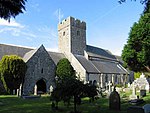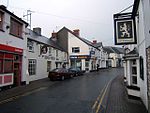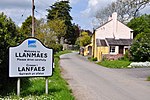Llantwit Major (Welsh: Llanilltud Fawr) is a town and community in Wales on the Bristol Channel coast. It is one of four towns in the Vale of Glamorgan, with the third largest population (13,366 in 2001) after Barry and Penarth, and ahead of Cowbridge. It is 4+1⁄2 miles (7.2 km) from Cowbridge, 9 miles (14 km) from Bridgend, 10 miles (16 km) from Barry, and 15 miles (24 km) from Cardiff. It had a population of 9,530 in 2021.
Llanilltud Fawr, named for the Llan of Saint Illtud, was home to the Monastery of Illtud and the college known as Bangor Illtyd. It became one of the most esteemed centres of Christian culture in the Celtic world. At its peak it had over 2,000 students, including princes, eminent clergymen, and revered saints. The institutions were destroyed by the raiding Vikings in 987, but Normans rebuilt the monastery in 1111 and it continued to be a centre of learning until it was disbanded in 1539 during the Dissolution of the Monasteries. The 13th-century St Illtyd's Church, near the ancient monastery, is a Grade I listed building and one of Wales' oldest parish churches.
In the 20th century, the modern town developed rapidly to accommodate Royal Air Force personnel from the St Athan base. Remnants of the medieval cobbled streets can be seen adjacent to 12th century Old Swan Inn; and numerous buildings of the 15th and 16th centuries remain.
Colhugh Beach is a popular surfing venue and has the remnants of an Iron Age fort and some of Wales' finest examples of Jurassic Period fossils. The pebble beach and its clifftops are protected by the Glamorgan Heritage Coast, which stretches for 14 miles (23 km) from Gileston to the east to Southerndown and Newton Point to the west.









